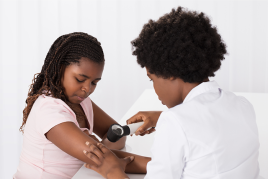Eczema types: Dyshidrotic eczema overview
What is dyshidrotic eczema?
This type of eczema causes tiny, intensely itchy blisters on the hands or feet. It is also called pompholyx.
Dyshidrotic eczema on a woman's palms
While dyshidrotic eczema may look contagious, you cannot catch it from someone.

The blisters of dyshidrotic eczema may last for three to four weeks before clearing. Some people never develop blisters again. Dyshidrotic eczema can also be a lifelong, debilitating disease.
For most people, having dyshidrotic eczema falls somewhere in between having it once and living with a chronic, debilitating condition.
With a dermatologist’s help, many people discover what triggers their blisters. Avoiding what triggers the blisters helps to reduce flare-ups.
Common triggers include personal care products like shampoo or soap. Coming into contact with nickel or cobalt can also lead to blisters. Nickel and cobalt are so common that it can be hard to avoid them. You find these metals in everything from jewelry and cell phones to the foods you eat.
Other common triggers include stress, sweat, and rising temperatures. For some people, dyshidrotic eczema develops every spring or summer and then clears when the temperature starts to fall. Having wet hands for long periods can also trigger dyshidrotic eczema.
If products you work with on your job trigger blisters, a dermatologist can help you protect your skin and prevent new blisters. Cutting oil and cement can be triggers you come in contact with at work.
While a dermatologist can help you reduce flare-ups, there is no cure for dyshidrotic eczema. Sometimes, treatment fails to prevent flare-ups. If you keep getting flare-ups, it’s important to keep working with your dermatologist to try other options.
Recent research has led to new treatments for difficult-to-treat dyshidrotic eczema. One newer option is a medication called dupilumab. This medication belongs to a class of medications called biologics. While dupilumab has only been given to relatively few patients, it has helped them when nothing else worked.
If you think you may have dyshidrotic eczema, you can see what it looks like and find out about the different signs and symptoms at, Dyshidrotic eczema: Symptoms.
Image
Image used with permission of DermNet NZ.
References
Amini S, Burdick AE, et al. [chief editor] James WD. “Dyshidrotic eczema (pompholyx).” Medscape. Last updated 4/22/2020. Last accessed 9/30/2020.
Guillet MH, Wierzbicka E. “A 3-year causative study of pompholyx in 120 patients.” Arch Dermatol. 2007;143(12):1504-8.
McGovern TW. “Dermatitis (Eczema).” In: Fitzpatrick JE, et al. Dermatology Secrets. Hanley & Belfus, Inc., USA, 1996:47-48.
Nishizawa A. “Dyshidrotic eczema and its relationship to metal allergy.” Curr Probl Dermatol. 2016;51:80-5.
Reider N, Fritsch PO. “Other eczematous eruptions.” In: Bolognia JL, et al. Dermatology. (fourth edition). Mosby Elsevier, China, 2018: 237-8.
Waldman RA, DeWane ME, et al. “Dupilumab for the treatment of dyshidrotic eczema in 15 consecutive patients.” J Am Acad Dermatol. 2020 May;82(5):1251-2.
Written by:
Paula Ludmann, MS
Reviewed by:
Dara D. Spearman, MD, FAAD
Elaine T. Kaye, MD, FAAD
Emily Chu, MD, PhD, FAAD
Last updated: 11/11/20
 Molluscum contagiosum: How to safely treat it
Molluscum contagiosum: How to safely treat it
 Biosimilars: 14 FAQs
Biosimilars: 14 FAQs
 Practice Safe Sun
Practice Safe Sun
 Relieve uncontrollably itchy skin
Relieve uncontrollably itchy skin
 Fade dark spots
Fade dark spots
 Untreatable razor bumps or acne?
Untreatable razor bumps or acne?
 Laser hair removal
Laser hair removal
 Scar treatment
Scar treatment
 Botox
Botox
 Free materials to help raise skin cancer awareness
Free materials to help raise skin cancer awareness
 Dermatologist-approved lesson plans, activities you can use
Dermatologist-approved lesson plans, activities you can use
 Find a Dermatologist
Find a Dermatologist
 What is a dermatologist?
What is a dermatologist?